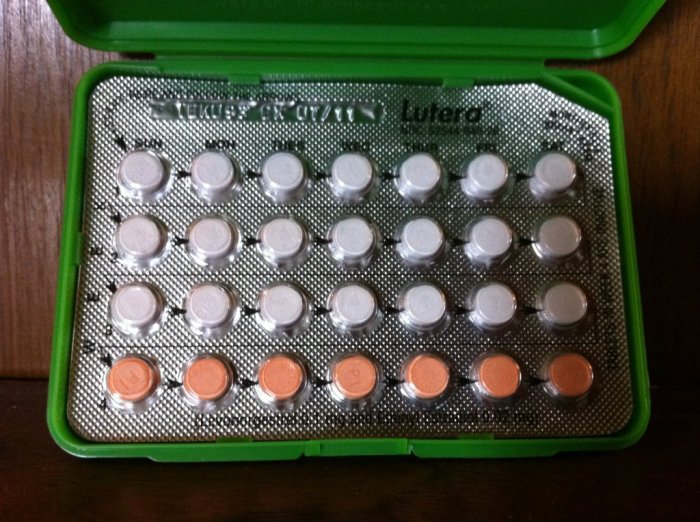Combination birth control pills are a popular method of contraception, but understanding the different types, their effectiveness, potential side effects, and benefits beyond preventing pregnancy is crucial. This comprehensive guide delves into the world of combination birth control pills, exploring everything from their hormonal makeup to how they impact the menstrual cycle. We’ll also look at how to choose the right pill for you and manage any potential side effects.
The different types of hormones found in combination birth control pills, such as estrogen and progestin, influence their effectiveness and potential side effects. This article details the diverse formulations and dosages, offering a comparative table for easy understanding. We will also discuss potential benefits beyond contraception, such as managing acne and menstrual cramps.
Overview of Combination Birth Control Pills

Combination birth control pills, also known as oral contraceptives, are a highly effective method of preventing pregnancy. They contain a combination of synthetic hormones, primarily estrogen and progestin, to regulate the menstrual cycle and prevent ovulation. Understanding how these pills work and the different types available is crucial for informed decision-making about reproductive health.These pills work by mimicking the hormonal changes that occur naturally in the body, thereby suppressing ovulation.
This prevents the release of an egg from the ovaries, which is a critical step in the fertilization process. Beyond pregnancy prevention, combination birth control pills can also offer benefits like regulating menstrual cycles, reducing menstrual cramps, and potentially lowering the risk of certain cancers. However, it’s important to discuss any concerns or potential side effects with a healthcare provider.
Types of Hormones
Combination birth control pills contain two main types of synthetic hormones: estrogen and progestin. Estrogen is a hormone that regulates various bodily functions, including the development and maintenance of female reproductive organs. Progestin, on the other hand, mimics the effects of progesterone, another crucial hormone in the menstrual cycle. The specific types and dosages of these hormones vary among different brands and formulations.
Methods of Pregnancy Prevention
Combination birth control pills prevent pregnancy primarily by suppressing ovulation. This means the ovaries do not release an egg, making fertilization impossible. Furthermore, the pills thicken the cervical mucus, making it difficult for sperm to reach the egg. The pills also alter the lining of the uterus, making it less hospitable for a fertilized egg to implant.
Dosages and Formulations
Combination birth control pills come in various dosages and formulations. The dosage of estrogen and progestin can vary, impacting the effectiveness and potential side effects. Different formulations include daily pills, weekly pills, and monthly pills, tailored to individual needs and preferences. Some formulations also include additional components that may offer extra benefits, such as reduced acne.
Comparison of Combination Birth Control Pills
| Pill Type | Active Ingredients | Dosage | Potential Side Effects |
|---|---|---|---|
| Low-Dose Loestrin Fe | Ethinyl estradiol 20 mcg, Norethindrone acetate 1 mg | One 20 mcg/1 mg tablet daily | Nausea, breast tenderness, headaches, mood changes, weight fluctuations |
| Yaz | Drospirenone 3 mg, Ethinyl estradiol 20 mcg | One 3 mg/20 mcg tablet daily | Headaches, bloating, breast tenderness, mood changes, increased risk of blood clots (compared to other formulations) |
| Yasmin | Drospirenone 3 mg, Ethinyl estradiol 20 mcg | One 3 mg/20 mcg tablet daily | Headaches, bloating, breast tenderness, mood changes, increased risk of blood clots (compared to other formulations) |
Note: This table provides examples and is not exhaustive. Always consult with a healthcare professional for personalized advice and to discuss potential side effects specific to individual circumstances. The specific side effects and their severity can vary from person to person.
Effectiveness and Safety
Combination birth control pills are a highly effective method of contraception when used correctly. Their effectiveness relies on a combination of hormones that prevent ovulation and thicken cervical mucus, making it difficult for sperm to reach the egg. However, like any medication, they come with potential risks and side effects, and regular check-ups are crucial for monitoring health.Understanding the potential benefits and drawbacks is essential for informed decision-making.
While generally safe for most women, individual responses can vary, making open communication with a healthcare provider vital. The effectiveness and safety profile of combination birth control pills also need to be considered alongside other contraceptive options.
Taking combination birth control pills consistently is key, just like remembering to take your thyroid medication at the same time each day. Proper timing is crucial for both, and knowing how to take your thyroid medication can help you better understand the importance of consistent medication schedules in general. For a detailed guide on ensuring you’re taking your thyroid medication correctly, check out this helpful resource: how to take your thyroid medication.
Ultimately, consistent pill-taking for both birth control and thyroid medication is vital for optimal health outcomes.
Effectiveness in Preventing Pregnancy
Combination birth control pills are remarkably effective at preventing pregnancy when taken consistently as directed. Studies have shown a very low failure rate when used correctly, typically less than 1% per year. This high effectiveness is due to the precise hormonal regulation that inhibits ovulation and alters cervical mucus, creating a barrier to fertilization. However, failure can occur if pills are missed or not taken at the correct time.
Potential Risks and Side Effects
While generally safe, some women experience side effects with combination birth control pills. These can range from mild, such as headaches or breast tenderness, to more serious, though less common, issues like blood clots or liver problems. Careful monitoring of any unusual symptoms is crucial.
Importance of Regular Check-ups
Regular check-ups with a healthcare provider are essential when using combination birth control pills. These appointments allow for the detection of potential side effects or complications early on. Doctors can also assess overall health and adjust the dosage or medication as needed. Furthermore, these check-ups enable early intervention if any concerning symptoms arise.
Comparison to Other Contraceptive Methods
Combination birth control pills are compared to other contraceptive methods based on their effectiveness, safety profile, and user experience. For example, barrier methods like condoms offer protection against sexually transmitted infections (STIs), but their effectiveness in preventing pregnancy varies based on correct usage. Long-acting reversible contraceptives (LARCs) like intrauterine devices (IUDs) are highly effective but may involve a slightly different procedure for insertion and removal.
Potential Side Effects Comparison
| Contraceptive Method | Potential Side Effects |
|---|---|
| Combination Birth Control Pills | Headaches, breast tenderness, mood changes, nausea, bloating, weight changes, blood clots (rare), increased risk of certain cancers (very rare), and possible interaction with other medications. |
| Condoms | Allergic reactions to latex, breakage or slippage, and potential STI transmission if not used correctly. |
| Intrauterine Devices (IUDs) | Pain or discomfort during insertion, expulsion risk, possible pelvic infections, and in rare cases, perforation of the uterus. |
| Implants | Pain or discomfort at the implant site, bleeding irregularities, and possible infection. |
| Natural Family Planning | Requires strict adherence to methods, potential for failure if not followed correctly, and can be challenging for irregular cycles. |
How Combination Birth Control Pills Work
Combination birth control pills, often just called “the pill,” are a popular and effective method of contraception. They work by mimicking the hormonal fluctuations of a normal menstrual cycle, ultimately preventing ovulation. Understanding how these pills manipulate the body’s natural hormonal processes can help women feel more empowered and informed about their reproductive health.The pill’s primary mechanism involves delivering synthetic hormones, estrogen, and progestin, in carefully calibrated doses.
These hormones work in concert to suppress the release of the body’s own natural hormones, which are crucial for ovulation and the thickening of the uterine lining. By effectively controlling these processes, the pill prevents pregnancy.
Hormonal Mechanisms of Action
Combination birth control pills contain synthetic versions of the hormones estrogen and progestin. These hormones are similar to the ones naturally produced by the ovaries. The precise balance and dosage of these synthetic hormones are crucial for the pill’s effectiveness. By delivering these hormones, the pill prevents ovulation, a key step in the reproductive process. The pill also alters the uterine lining, making it less hospitable to a fertilized egg.
Combination birth control pills can be a game-changer for managing your cycle, but they can sometimes have surprising side effects. One less-discussed side effect is the potential for a black line appearing on your nails, which can be a cause for concern. For more information on what a black line on your nail might indicate, check out this helpful resource on black line on nail.
Ultimately, if you’re experiencing unusual changes, it’s always best to consult your doctor, especially if you’re taking combination birth control pills.
Stages of the Menstrual Cycle and Pill Influence
The menstrual cycle is a complex interplay of hormones, and the pill directly interferes with this intricate process. The pill essentially “tricks” the body into believing it is already pregnant, thus preventing the release of the egg. The menstrual cycle has four main phases: follicular, ovulatory, luteal, and menstrual.
- Follicular Phase: During this phase, the ovaries prepare to release an egg. The pill’s estrogen suppresses the release of follicle-stimulating hormone (FSH), preventing the maturation of follicles containing eggs. This suppression is crucial in preventing ovulation.
- Ovulatory Phase: The pill’s progestin further inhibits the release of luteinizing hormone (LH), which is essential for ovulation. By preventing LH surge, the pill effectively stops the release of the egg.
- Luteal Phase: Even if an egg were released, the pill’s hormones thicken the cervical mucus, making it difficult for sperm to reach the egg. The uterine lining is also altered, making it less receptive to implantation.
- Menstrual Phase: In the absence of pregnancy, the pill prevents the thickening of the uterine lining and thus the shedding of the lining, which is the menstrual flow.
Illustrative Diagram of Hormonal Interactions
(Imagine a diagram here. A circle representing the ovaries. Arcing lines representing hormones (estrogen, progestin, FSH, LH) flowing from the ovaries to the pituitary gland and uterus. The pill’s synthetic estrogen and progestin are shown as thicker lines interfering with the natural hormonal flow. Arrows should indicate the direction of hormone influence.
The diagram should clearly show how the pill’s hormones suppress FSH and LH release, thus preventing ovulation. The diagram should highlight how the pill also affects the uterine lining. The diagram should also highlight the suppression of ovulation, preventing pregnancy.)The diagram would visually represent the interplay of hormones and how the pill’s hormones counteract the natural hormonal processes, thus preventing ovulation and pregnancy.
Potential Benefits Beyond Contraception
Combination birth control pills offer more than just pregnancy prevention. Beyond their primary function, these pills can significantly impact various aspects of a woman’s health. Understanding these potential benefits can help women make informed decisions about their reproductive health and overall well-being.While the primary function of combination birth control pills is contraception, they also demonstrate a range of secondary effects that are often beneficial for managing certain medical conditions.
This versatility stems from the hormonal components within the pills, which interact with the body in various ways. These interactions can positively influence the management of conditions like acne, menstrual irregularities, and even bone health.
Managing Acne
Combination birth control pills are frequently prescribed to help manage acne. The hormones in these pills, primarily estrogen and progestin, work to regulate sebum production, which is the oily substance that can contribute to clogged pores and acne breakouts. By reducing sebum production, the pills can help clear up skin and lessen the severity of acne. Many women experience a significant reduction in acne, or even complete resolution, while using these pills.
Alleviating Menstrual Cramps
The hormonal components in combination birth control pills can also help regulate the menstrual cycle and reduce the intensity of menstrual cramps. By regulating hormone levels, the pills can lessen the fluctuations that contribute to painful cramping. This is particularly beneficial for women who experience severe menstrual discomfort.
Affecting Menstrual Cycles
Combination birth control pills can significantly influence menstrual cycles. They often lead to lighter, shorter, and more regular periods, minimizing the discomfort associated with irregular or heavy bleeding. The regularity of cycles can also improve predictability for women who experience issues like PMS.
Impact on Bone Health
Studies suggest that combination birth control pills may contribute to better bone health in some women. Estrogen, a key component, plays a role in bone density maintenance. However, this effect is not uniform and can vary among individuals. The long-term impact on bone health requires further research.
Summary of Non-Contraceptive Benefits
| Condition | Potential Benefit |
|---|---|
| Acne | Reduced sebum production, improved skin clarity, decreased acne severity. |
| Menstrual Cramps | Reduced intensity of menstrual cramps, lighter and shorter periods. |
| Menstrual Cycles | Regularization of cycles, improved predictability. |
| Bone Health | Potential positive impact on bone density; further research needed. |
Choosing the Right Pill
Picking the right birth control pill is a significant decision. It’s not a one-size-fits-all approach, and the best option depends on individual needs and circumstances. This choice should be made in collaboration with a healthcare professional to ensure safety and effectiveness. Factors like your medical history, lifestyle, and preferences play a crucial role in finding the most suitable pill.Understanding the various formulations, brands, and potential benefits beyond contraception is essential for informed decision-making.
This process should involve thorough discussion with your doctor to identify the best fit for your unique needs and health.
Combination birth control pills are a common choice for managing hormonal imbalances, but managing inflammation is also key. Considering the potential impact on overall health, exploring natural remedies like turmeric tea for inflammation, which can be found in articles like turmeric tea inflammation uses benefits and types , might offer a complementary approach. Ultimately, consulting a healthcare professional remains crucial when considering any lifestyle changes, especially regarding birth control options.
Factors to Consider
Choosing the right combination birth control pill requires careful consideration of several factors. Your health history, current medications, and lifestyle preferences are all crucial elements. Addressing these aspects with your doctor is paramount to ensuring optimal results and safety.
Medical History and Current Health Conditions, Combination birth control pills
Your medical history, including any pre-existing conditions or allergies, is a vital consideration. Certain health conditions may necessitate specific formulations or require adjustments to the chosen pill. For example, women with a history of blood clots or migraines may need to carefully consider the hormones contained in the pill. Also, current medications, including over-the-counter supplements, can interact with the pill, potentially affecting its effectiveness or causing side effects.
Open communication with your healthcare provider about your entire medical history is essential.
Lifestyle Preferences and Needs
Beyond medical factors, lifestyle preferences also play a role. Consider your daily routine and the potential impact of different formulations on your body. Some women prefer pills with a shorter hormone-free interval, while others prioritize pills with fewer side effects. Understanding these preferences and discussing them with your doctor can help find a pill that aligns with your daily life.
Pill Formulations and Brands
Different brands and formulations of combination birth control pills contain varying levels of estrogen and progestin. The specific combination can influence side effects and effectiveness. For instance, some pills have a lower estrogen content, potentially reducing the risk of side effects like breast tenderness or headaches. It’s important to discuss the various formulations and brands available to determine which best suits your individual needs.
Consulting a Healthcare Professional
Consulting a healthcare professional is paramount in selecting the right combination birth control pill. They can assess your medical history, current health conditions, and lifestyle preferences to recommend the most suitable option. A thorough discussion is essential to address any concerns or questions you may have.
Questions to Ask Your Healthcare Provider
Here’s a list of important questions to ask your healthcare provider regarding birth control pill selection:
- What are the different types of combination birth control pills available?
- What are the potential side effects of each formulation?
- How do the hormones in each pill formulation compare, and what are the potential implications for my health?
- Are there any interactions between this pill and my current medications or supplements?
- What is the best way to manage potential side effects?
- What are the long-term implications of using this particular pill?
- How can I ensure that I’m taking the pill correctly?
- What are the alternatives if this pill doesn’t work well for me?
- What is the return policy if I am not satisfied with the pill?
Side Effects and Management

Combination birth control pills, while highly effective, can sometimes cause side effects. Understanding these potential side effects and how to manage them is crucial for a positive experience. This section will detail common side effects and strategies for managing them, emphasizing the importance of open communication with your healthcare provider.
Potential Side Effects
A wide range of potential side effects can be associated with combination birth control pills. These range from mild and temporary to more serious and requiring medical attention. Understanding the potential spectrum of effects is vital for informed decision-making.
- Common Side Effects: These are often mild and temporary, and may include headaches, nausea, breast tenderness, bloating, weight changes, mood swings, and changes in libido. These are often manageable, and many women experience these side effects only initially as their body adjusts to the medication.
- Less Common Side Effects: These side effects are less frequent but still possible. They may include changes in menstrual bleeding patterns (such as spotting or absence of periods), vaginal infections, skin changes, and fatigue. It is important to note that these effects are often temporary and may resolve as the body adjusts.
- Rare but Serious Side Effects: While rare, some side effects are serious and require immediate medical attention. These include severe headaches, chest pain, shortness of breath, severe abdominal pain, vision changes, swelling in the legs or feet, and unexplained bruising or bleeding. Prompt medical intervention is crucial in these cases.
Managing Common Side Effects
Many common side effects of combination birth control pills can be managed effectively. The key is often to adjust to the medication and/or discuss management strategies with your healthcare provider.
- Headaches: Over-the-counter pain relievers, like ibuprofen or acetaminophen, can often help. Lifestyle adjustments, such as stress reduction techniques, may also provide relief. If headaches are severe, persistent, or accompanied by other symptoms, consult your doctor immediately.
- Nausea: Taking the pill with food, or at a different time of day, may help reduce nausea. Some women find that eating smaller, more frequent meals can also aid in managing this side effect. If nausea is severe or persistent, consult your doctor.
- Mood Changes: Mood changes can be complex and influenced by various factors. If mood changes are significant or disruptive, discussing them with your doctor is crucial. Addressing underlying mental health concerns or adjusting the medication might be necessary.
Importance of Reporting Unusual or Severe Side Effects
It’s crucial to communicate any unusual or severe side effects to your healthcare provider immediately. Early detection and intervention can prevent potential complications.
- Prompt Reporting: If you experience any severe side effects, such as chest pain, shortness of breath, or severe abdominal pain, contact your healthcare provider immediately.
- Detailed Communication: When reporting side effects, provide as much detail as possible. This includes the severity, duration, and any other accompanying symptoms.
- Healthcare Provider’s Role: Your healthcare provider can assess the situation and determine the appropriate course of action. They can help you determine if the side effect is related to the pill or another factor and offer tailored advice.
Common Side Effects and Remedies
The following table Artikels common side effects and potential remedies/management strategies. Remember, this is not an exhaustive list, and consulting your healthcare provider is always recommended.
| Side Effect | Potential Remedies/Management Strategies |
|---|---|
| Headache | Over-the-counter pain relievers (ibuprofen, acetaminophen); lifestyle adjustments (stress reduction); consult doctor if severe or persistent. |
| Nausea | Taking the pill with food; adjusting the time of day; eating smaller, more frequent meals; consult doctor if severe or persistent. |
| Breast Tenderness | Wearing a supportive bra; applying a warm compress; pain relievers if needed; consult doctor if severe or persistent. |
| Mood Swings | Maintain a healthy lifestyle (diet, exercise, sleep); consult doctor if significant or disruptive. |
Interactions and Considerations: Combination Birth Control Pills
Knowing your combination birth control pill’s potential interactions is crucial for safety and effectiveness. Many medications and supplements can affect how the pill works, sometimes leading to reduced effectiveness or unwanted side effects. Understanding these interactions helps you make informed decisions about your health and well-being.This section details potential drug interactions and highlights the importance of open communication with your healthcare provider about all medications and supplements you’re taking.
It also discusses situations where certain pills might not be the best choice for you.
Potential Drug Interactions
Many medications can interact with combination birth control pills, potentially decreasing their effectiveness. This can lead to unintended pregnancy. It’s essential to be aware of these interactions and to discuss them with your doctor. Some examples include certain antibiotics, anti-seizure medications, and some antifungal medications.
Interactions with Other Medications or Supplements
Certain supplements, like St. John’s Wort, can also interfere with the effectiveness of birth control pills. These interactions often stem from the way the supplements alter the body’s ability to metabolize the hormones in the pill. Additionally, some herbal remedies can interact with the pill’s hormones, potentially reducing their effectiveness.
Importance of Informing Healthcare Providers
Openly communicating all medications and supplements to your healthcare provider is paramount. This includes prescription drugs, over-the-counter medications, herbal remedies, and even vitamins or dietary supplements. This comprehensive information allows your doctor to assess potential interactions and adjust your birth control method as needed.
Specific Circumstances Where Certain Pills Might Not Be Suitable
Certain medical conditions or situations might make certain combination birth control pills unsuitable. For instance, women with a history of blood clots, severe liver disease, or certain cardiovascular conditions should carefully consider their options and discuss the risks with their healthcare provider. Also, individuals with a family history of certain health issues might need to be extra cautious and seek professional guidance before starting a birth control pill regimen.
Specific Examples of Interactions
| Medication/Supplement | Potential Interaction | Impact on Birth Control |
|---|---|---|
| Certain Antibiotics | Can reduce the effectiveness of the birth control pill | Increased risk of pregnancy |
| St. John’s Wort | Can reduce the effectiveness of the birth control pill | Increased risk of pregnancy |
| Anti-seizure medications | Can reduce the effectiveness of the birth control pill | Increased risk of pregnancy |
It is crucial to inform your doctor about all medications and supplements you are taking, to avoid potential interactions.
Additional Resources and Further Reading
Staying informed about combination birth control pills is crucial for making well-informed decisions about your health. Beyond the information presented here, there are numerous reliable resources available to delve deeper into specific aspects and explore related topics. These resources can provide a broader perspective and help you understand the nuances of this form of contraception.
Reliable Sources of Information
Various reputable organizations and websites offer comprehensive information on combination birth control pills. These resources are valuable for gathering detailed information and clarifying any lingering questions. They often provide evidence-based data and expert opinions.
- The American College of Obstetricians and Gynecologists (ACOG): ACOG is a trusted source for women’s health information, including detailed guidelines and recommendations regarding birth control options. Their website offers evidence-based articles, fact sheets, and educational materials for healthcare providers and patients alike.
- Planned Parenthood: Planned Parenthood provides accessible and comprehensive information about contraception, including various types of birth control, including combination birth control pills. Their website is user-friendly and provides clear explanations, making it easy to understand complex information.
- The National Institutes of Health (NIH): NIH offers a wide range of health information, including resources on women’s health and contraception. This is a valuable resource for in-depth scientific information about the effectiveness and safety of birth control pills.
Organizations Offering Support and Guidance
Seeking support from organizations dedicated to reproductive health can be invaluable. These groups provide personalized guidance and resources to help individuals navigate the complexities of birth control.
- Local health clinics and family planning centers: These clinics often offer counseling and support services related to birth control. Clinics are equipped to answer specific questions, discuss individual needs, and offer personalized guidance regarding the right type of birth control for a given individual.
- Reproductive health support groups: Online or in-person support groups can offer a safe and supportive space for individuals to share experiences and ask questions. These groups provide a sense of community and shared understanding regarding birth control.
Locating Accurate Information on Health Websites
Finding accurate information on health websites requires careful consideration. Scrutinizing the source and ensuring its credibility is essential for avoiding misinformation.
- Look for author credentials and affiliations: Reputable health websites usually have author bios outlining their credentials and affiliations with recognized medical institutions. This demonstrates the author’s expertise in the field.
- Verify the website’s reputation and accreditation: Research the website’s reputation and accreditation to ensure its reliability. Look for websites associated with trusted medical organizations or universities.
- Check for citations and references: Credible health websites provide citations and references to support the information presented. These citations allow you to trace the evidence behind the claims and verify the information’s accuracy.
Last Recap
In conclusion, understanding combination birth control pills involves considering the various hormonal interactions, potential benefits and risks, and personal factors. Consulting with a healthcare professional is essential to choose the right pill and manage potential side effects effectively. This guide aims to provide a comprehensive overview, empowering you to make informed decisions about your reproductive health. Remember, individual experiences can vary, so consulting a doctor is crucial for personalized advice.







